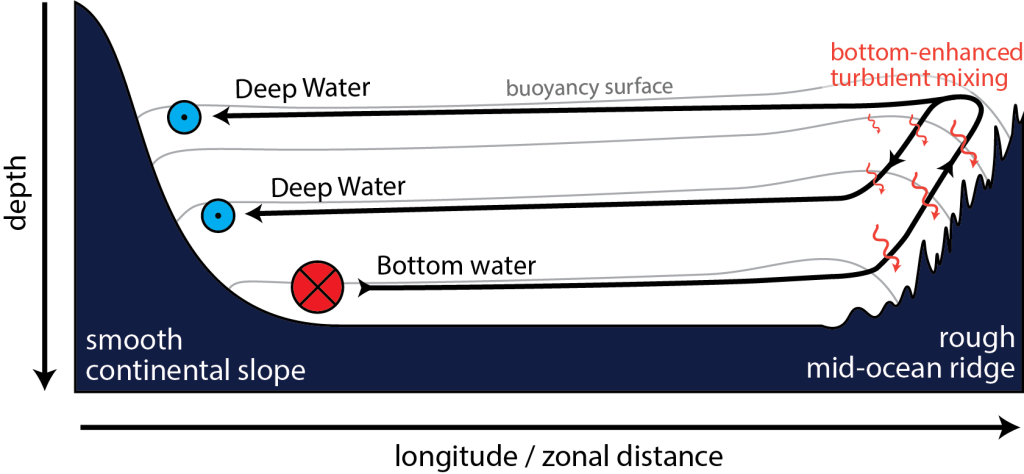Lab mission
We study the geophysical fluid dynamics of the ocean and their role in the coupled dynamics of the Earth system. Our research questions are first and foremost driven by curiosity but are generally motivated by the challenge of mitigating and adapting to human-caused climate changes on decadal to centennial timescales. Our methods include hierarchies of ocean and climate models, ranging from pen-and-paper mathematical solutions to comprehensive Earth system model simulations run on the world’s biggest supercomputers. We train students and post-graduates to become independent researchers, collaborative scholars, and leaders at the frontier of ocean and climate science, preparing them for future careers in academia, public service, and private industry.

Current research areas
Ocean waves, instabilities, turbulence, and tracer transport
The flows of climatically important tracers (like heat and carbon) into the deep ocean shape Earth’s climate change trajectory. The turbulent nature of ocean currents makes their inclusion in predictive climate models challenging. While the largest of these oceanic flows emerge naturally from solving the equations of fluid mechanics on a discretized grid, those that occur on scales smaller than a grid cell need to be added in separately using theoretical or empirical “parameterizations” that depend only on the resolved scales. We are particularly interested in the energetic pathways from submesoscale (1–100 km) linear waves and instabilities to turbulence and—ultimately—to mixing and dissipation, because of their roles in energizing or damping large-scale ocean currents. We develop simple theoretical models of deep ocean transport processes and test these ideas with available oceanographic data and high-resolution realistic simulations. We apply these methods to 1) improve theoretical understanding of the global ocean circulation, 2) develop new parameterizations for sub-gridscale transport in climate models, 3) and leverage these tools to interpret existing observations and inform the development of observational campaigns (such as the recent Bottom Layer Turbulence and Abyssal Recipes program).
[Source: Drake et al. 2022, Journal of Physical Oceanography]
Theories of the general ocean circulation
State-of-the-art general circulation models provide remarkably precise representations of large-scale ocean currents, but their complexity also obscures the fundamental physical mechanisms responsible for the circulation patterns that emerge. We use hierarchies of increasingly complex ocean models to ground our understanding of the general ocean circulation in fundamental geophysical fluid dynamics and to pinpoint key dynamical mechanisms. A major area of focus is the wind– and buoyancy–driven Meridional Overturning Circulation, the global ocean current system that ventilates the deep ocean. The goal of this kind of work is typically to derive algebraic scaling laws for the strength and structure of the circulation based only on external parameters (e.g. the wind stress acting on the ocean surface and surface heat/freshwater fluxes). While these simple theories are obviously useful for pedagogy, they also serve more practical uses: 1) they are the basis for lower-complexity Earth system models (for long timescale or large ensemble simulations), 2) they motivate future Earth system model development and experimental design, and 3) they help target oceanographic field campaigns.

[Source: Drake et al. 2020, Journal of Physical Oceanography]
Warming ocean currents and melting ice sheets
While global warming is caused by the accumulation of anthropogenic greenhouse gases in the atmosphere, over 90% of this excess heat is transferred into the ocean. The ocean does us a service by slowing climate change down in this way, but it comes at great cost: seawater becomes less dense as it warms, leading to rising sea levels that damage coastal infrastructure and displace coastal populations. Unfortunately, the story does not end here; as this warming makes its way to the base of marine-terminating ice sheets, it causes them to melt from below (as in the case of Antarctica’s many floating ice shelves), further accelerating sea level rise. The resulting flux of fresh meltwater into the salty ocean in turn affects seawater density and its circulation, opening the possibility for either stabilizing or destabilizing feedback loops. Leveraging ESS’ long-standing expertise in glaciology, we study the long-term evolution of oceans and ice sheets as a coupled system to reduce bias and uncertainty in predictions of climate impacts like sea level rise.
[Source: Drake et al. (2018), Geophysical Research Letters]
Geophysical constraints on ocean-based climate solutions
As land-based climate solutions scale up and begin experiencing diminishing returns or reaching fundamental limits, ocean-based climate solutions will become increasingly important. Examples include 1) harvesting renewable energy from ocean waves, currents, or thermal gradients; 2) artificially enhancing the dissolution, export, or sequestration of carbon in the ocean; 3) artificially cooling the surface to trigger radiative feedbacks; and 4) mining the deep sea for the rare minerals required by zero-carbon technologies. Enthusiasm for these technologies is far outpacing the basic science they depend on—we aim to fill that gap with geophysical research that evaluates the extent to which these technologies really are “solutions” to the climate problem.